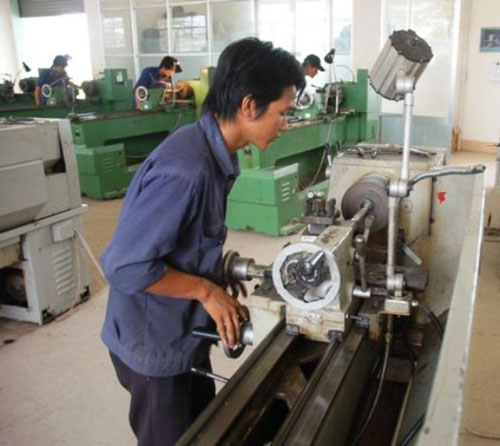Regulations on Minimum Knowledge in Metal Cutting for Associate Degree Program
Circular 47/2018/TT-BLDTBXH issued by the Ministry of Labor, Invalids and Social Affairs, stipulating the minimum volume of knowledge and competency requirements that learners must achieve upon graduation from intermediate and college levels in mechanical engineering fields, is effective from February 10, 2019.

Minimum knowledge requirements for the metal cutting and shaping sector at college level - Illustrative image
According to the requirements of minimum knowledge volume and competency that students must achieve after graduating at intermediate and college level in the metal cutting and shaping sector, issued together with Circular 47/2018/TT-BLDTBXH, the minimum knowledge that students must achieve after graduating in the metal cutting and shaping sector at college level is as follows:
- Analyze basic material symbols: cast iron, steel, various alloys;- Analyze symbols for fitting tolerances, fitting schemes, dimensional chains;- Describe the characteristics, structure, and working principles of various machine tools: universal lathe, universal milling machine, planer-shaper, grinder, CNC lathe, CNC milling machine, EDM machine, wire-cut machine...;- Describe the physical and mechanical properties of materials used for cutting tools (blades, grinding wheels, metal and non-metal machining materials), heat treatment characteristics of common carbon steels, alloy steels, and steels used for turning, milling, planning tools, drills, reamers, chisels, files... after heat treatment;- Describe the characteristics of fitting, geometrical shape and positional errors, surface roughness, dimensional chains;- Describe the structure, working principles, technical features, application scope of measuring tools, measurement methods, reading dimensions, and calibrating various calipers, micrometers, dial indicators, universal angle gauges, bore gauges...;- Analyze the structure of parts, machine assemblies, and transmission chains of the machine;- Describe the operating principles of three-phase asynchronous motors, uses, and methods of using some types of electrical tools used in machine tools;- Describe the rules, regulations on labor safety, industrial hygiene, fire and explosion prevention, 5S procedures for production facilities, measures to increase productivity;- Analyze the technical characteristics, structure, working principles, use methods, and preservation of tools (clamps, cutters, checking...) on various machine tools;- Describe basic machining methods on CNC lathes, CNC milling machines, universal lathes, universal milling machines, grinders, boring machines, drills, electrical discharge machining... identify types of defects, causes, and preventive measures;- Describe the technological process of machining parts as required;- Describe basic knowledge of politics, culture, society, law, national defense and security, physical education as prescribed.
For detailed regulations, see Circular 47/2018/TT-BLDTBXH, issued on December 28, 2018.
Le Vy
- Responsibilities of officials of the Ministry of Finance of Vietnam when they are issued Official Passports from November 19, 2024
- 06 solutions to enhance the effectiveness of social policy credit in the new phase in Vietnam
- Financial support level for the purchase and repair of transportation vehicles for the Economic - National Defense Corps in Vietnam from December 30, 2024
- Financial support levels for purchasing and repairing of medical equipment for the Economic - National Defense Corps in Vietnam from December 30, 2024
- Latest regulations on management and use of passports for officials and public employees of the Ministry of Finance of Vietnam
- New regulations on the procedures for veterinary sanitation inspection in Vietnam from January 6, 2025
-

- Responsibilities of officials of the Ministry ...
- 16:00, 23/11/2024
-

- 06 solutions to enhance the effectiveness of social ...
- 15:32, 23/11/2024
-

- Guidelines for registration and organization of ...
- 11:53, 23/11/2024
-

- Contents of audit service quality control in Vietnam
- 11:00, 23/11/2024
-

- Acts in violation of Law on Independent Audit ...
- 10:30, 23/11/2024
 Article table of contents
Article table of contents
